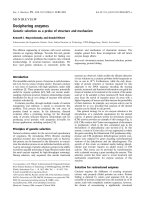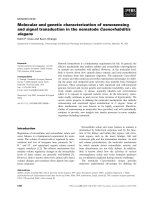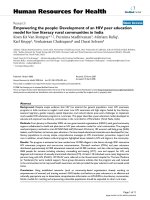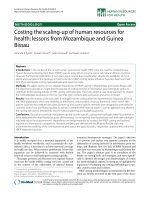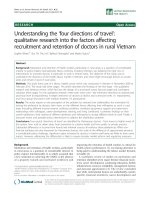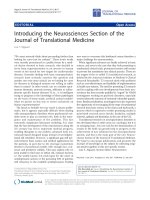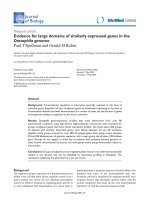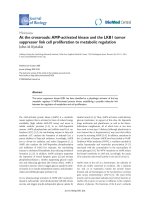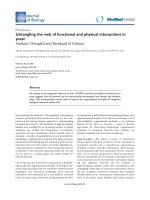Báo cáo sinh học: "Deciphering the genetic code of morphogenesis using functional genomics" pdf
Bạn đang xem bản rút gọn của tài liệu. Xem và tải ngay bản đầy đủ của tài liệu tại đây (203.68 KB, 4 trang )
Vichas and Zallen: Journal of Biology 2009, 8:76
Abstract
A fundamental goal of developmental biology is to define the
molecular mechanisms that control cell behavior during morpho-
genesis. A recent study in BMC Biology combines gene expres-
sion profiling, bioinformatics and functional analysis to identify
genes that shape the Drosophila embryo.
See related research article />Morphogenesis of the Drosophila embryo requires the
three-dimensional organization of populations of cells
with characteristic shapes and behaviors that give rise
to the adult structure of the animal. Genetic screens
have been instrumental in identifying genes that specify
cell fate and cell behavior. Many of these include
transcription factors that are expressed in precise
spatial patterns and are required for distinct
morphological behaviors. However, the downstream
pathways that translate cell fate decisions into cell
shape and tissue structure are not fully under stood.
Current advances in genome-wide expression profiling,
in vivo transcription factor binding site analysis and
high-throughput studies of gene-expression patterns
have made it possible to identify novel genes that are
expressed during morphogenetically active periods of
development.
Since the sequencing of the Drosophila genome, large-
scale expression studies using DNA microarrays have
been employed in diverse ways to reveal the genetic
networks that drive development. Time-course
experiments using DNA microarrays have identified
subsets of genes expressed at specific developmental
stages throughout Drosophila embryogenesis [1-5]. The
first few hours of embryogenesis are marked by active
changes in cell fate, cell shape and cell rearrangements
that are accompanied by dynamic changes in gene
expression. Recent studies have deter mined that more
than 2,000 genes, or approximately 15% of the genome,
display increased expression at these early stages [3-6].
These systematic genome-wide approaches provide a
global perspective on the dynamics of gene expression
during embryonic development.
A major challenge now posed by these studies is how to use
the overwhelming amount of information from whole-
genome studies to identify specific genes with key roles in
embryonic morphogenesis. The ability to integrate data
from stage-specific gene-expression studies, high-through-
put spatial analysis of gene-expression patterns and
bioinformatics tools for protein sequence analysis is critical
to the process of candidate gene selection (Figure 1). The
paper published in BMC Biology by Cambiazo and
colleagues (Zúñiga et al. [7]) describes an integrated
genome-wide approach to finding genes that are
specifically upregulated during early Drosophila
development. The authors use differential gene-expression
profiling, bioinformatics, in situ analysis and functional
characterization to identify a novel gene that is required for
embryonic morphogenesis, as well as a number of
interesting candidate genes for future functional analysis.
Here, we discuss how these and other genomic datasets
have been coupled with targeted functional analysis to gain
insight into the molecular mechanisms underlying
morphogenesis.
An integrative approach to identify genes
required for morphogenesis
Gastrulation in the early Drosophila embryo is charac ter-
ized by a wholesale reorganization of the embryo driven by
region-specific changes in cell shape and cell movement.
For these morphogenetic events to be properly executed
cells must communicate with each other to coordinate
their behavior with other cells and tissues in the embryo.
To elucidate the molecular mechanisms underlying these
processes, an essential step is to identify the extracellular
signals that mediate communication between cells and the
transmembrane receptors that detect and interpret these
signals and translate them into cell shape and behavior.
Using suppression subtractive hybridization (SSH) and
micro array analysis, Zúñiga et al. [7] isolated a set of trans-
cripts that are differentially expressed between gastrulating
and blastoderm Drosophila embryos. The SSH technique
is able to circumvent the inability of most high-throughput
gene-expression profiling techniques to isolate transcripts
of low abundance [8]. Using this method, the authors
Minireview
Deciphering the genetic code of morphogenesis using functional
genomics
Athea Vichas and Jennifer A Zallen
Address: Developmental Biology Program, Sloan-Kettering Institute, 1275 York Avenue, New York, NY 10065, USA.
Correspondence: Jennifer Zallen. Email:
76.2
Vichas and Zallen: Journal of Biology 2009, 8:76
identified 114 genes and 4 noncoding RNAs that are more
highly expressed in gastrulating embryos compared to the
earlier blastoderm stages. To validate their experimental
approach, the authors compared their gene list with the
approximately 2,000 genes found to be expressed in the
early embryo in other genome-wide expression studies
[1-6,9]. More than half of the genes identified were
previously reported to be expressed during gastrulation. In
addition, their list contains 55 genes that have not been
functionally characterized. Two of these genes are not
represented on commercially available gene-expression
chips, indicating that this technique is able to isolate
transcripts that were not previously predicted. Of note, 19
of the novel genes are predicted to encode secreted or
transmembrane proteins that may play a direct role in cell-
cell communication during morphogenesis. Using in situ
analysis the authors were able to determine that 12 out of
15 of these genes are expressed in a spatially restricted
pattern in regions undergoing distinct morphogenetic
processes.
This series of studies led to the identification of a novel
secreted protein with a putative transmembrane domain
that is specifically expressed in the dorsal region of the
embryo. Using an RNA interference (RNAi) knock-down
strategy, the authors provide evidence for a requirement
for this gene during germband retraction, a process that
requires regulation of cell shape changes and cell death.
Consistent with these findings, this gene is a direct target
of Medea, a transcription factor required for dorsal
specification in the embryo [10,11]. It will be of interest to
determine whether other genes identified in this screen are
direct targets of the transcription factors that control
morphogenesis during development.
Genome-wide analysis to identify genes
downstream of cell fate
Given the extensive information from genetic studies about
the transcriptional regulators that direct the early morpho-
genetic events of embryogenesis, it is now possible to use
whole-genome comparative analysis to look for changes in
gene expression in response to altering the levels of
particular transcription factors. To identify direct targets of
these transcription factors, chromatin immuno precipi ta tion
(ChIP) followed by microarray hybridization on whole-
genome tiling arrays can be used to determine in vivo
protein-DNA interactions. Work from the Berkeley Drosophila
Transcription Network Project (BDTNP) has characterized
the in vivo DNA binding sites of 21 transcription factors in
the Drosophila blastoderm embryo [11]. These studies find
that each transcription factor is bound to more than 1,000
different sites, suggesting a complex transcriptional
program downstream of these regulators. Combining this
approach with microarray studies has been successful at
Figure 1
Strategies for selecting candidate genes from expression studies for functional analysis. This schematic depicts various approaches to
selecting candidate genes for functional characterization. First, the temporal and spatial expression patterns of genes can be determined by
integrating information from experimental and available datasets. Second, genes can be prioritized on the basis of predicted or known
protein function. Finally, a subset of candidate genes can be functionally analyzed using genetic analysis, which can be labor intensive, or
high-throughput methods such as RNA interference.
Gene ontology (Flybase)
Domain structure (SMART)
Protein-protein interactions (FlyGrid)
Published expression data (Gene Expression Omnibus)
Transcription factor binding site (FlyNet & BDNTP)
Flymine.org - Integrated genomic, expression and protein database
Functional analysis
External databases
Spatial expression
Fly-FISH - mRNA localization patterns
BDGP - gene expression database
Literature
Experiment
Gene expression profiling
76.3
Vichas and Zallen: Journal of Biology 2009, 8:76
identifying direct targets of transcription factors required
for embryonic segmentation [12].
While microarray analysis and ChIP:chip data can provide
insight into the temporal expression and transcriptional
regulation of genes during development, these approaches
do not offer clues as to the spatial distribution of gene
expression. Combining in situ expression patterns with
genomic data on expression levels is one way to identify
sets of genes involved in related developmental processes.
In Drosophila, two groups have determined the spatial and
temporal expression patterns of around 25% of the genes
expressed in the embryo [2,6]. Lecuyer et al. [6], used
fluorescent in situ hybridization (FISH) to generate high-
resolution images for around 2,500 mRNAs throughout
early Drosophila embryogenesis. This approach, which
allows for single-cell resolution, led to the surprising
discovery that over 70% of detected mRNAs are
subcellularly localized, suggesting that uncharacterized
transcripts can be classi fied on the basis of their
localization as well as their expression. Both groups have
generated web-based data bases that offer a range of search
options, including stage, tissue, gene name and predicted
function. Analysis of these rich datasets may identify genes
involved in morphogenesis that have failed to be identified
in genetic screens.
The ultimate goal of developmental biology is to define
how each gene contributes to cell fate, cell shape and cell
behavior during morphogenesis. However, functional
studies are often labor-intensive and are not readily
adapted to high-throughput analysis, creating a bottleneck
in going from expression to function. RNAi screening is
emerging as a powerful technique for functional analysis in
vivo [13]. Expression profiling has been coupled with
double-stranded RNA injections in early embryos to
identify genes required for cellularization and embryonic
viability [3]. One limitation of traditional genetic screens is
the inability to identify genes with subtle or redundant
phenotypes, as well as components involved in multiple
processes throughout development. The genome sequence
creates the potential to identify gene families, which can be
tested for redundant functions using combinatorial RNAi
[14].
Future directions: the shape of things to
come
In the past decade, genome-wide studies have provided
insight into the dynamics of gene expression during
development [1,4,5]; revealed the spatial localization of
mRNA transcripts at the cell and tissue levels [2,6]; and
mapped the DNA binding sites of essential transcription
factors [10,11]. With this rapid proliferation of data, the
current challenge is to develop the tools to translate the
information contained in these data sets into meaningful
biological insight.
The study by Zúñiga et al. [7] highlights the value of
integrating information from temporal and spatial
expression studies with protein sequence analysis to
generate a short list of candidate genes for functional
analysis. Moreover, the experimental approach undertaken
by Zúñiga et al. has provided a dataset enriched for genes
with potential regulatory roles in Drosophila embryo-
genesis. Future studies of this kind will help to determine
how the expression of cell-fate determinants ultimately
leads to the cell-shape changes and cell movements that
shape the embryo.
References
1. Arbeitman MN, Furlong EE, Imam F, Johnson E, Null BH,
Baker BS, Krasnow MA, Scott MP, Davis RW, White KP: Gene
expression during the life cycle of Drosophila melanogas-
ter. Science 2002, 297:2270-2275.
2. Tomancak P, Beaton A, Weiszmann R, Kwan E, Shu SQ, Lewis
SE, Richards S, Ashburner M, Hartenstein V, Celniker SE,
Rubin GM: Systematic determination of patterns of gene
expression during Drosophila embryogenesis. Genome
Biol 2002, 3:research0088.1-0088.14.
3. Pilot F, Philippe JM, Lemmers C, Chauvin JP, Lecuit T:
Developmental control of nuclear morphogenesis and
anchoring by charleston, identified in a functional genomic
screen of Drosophila cellularisation. Development 2006,
133: 711-723.
4. De Renzis S, Elemento O, Tavazoie S, Wieschaus EF:
Unmasking activation of the zygotic genome using chro-
mosomal deletions in the Drosophila embryo. PLoS Biol
2007, 5:1036-1051.
5. Hooper SD, Boue S, Krause R, Jensen LJ, Mason CE, Ghanim
M, White KP, Furlong EE, Bork P: Identification of tightly reg-
ulated groups of genes during Drosophila melanogaster
embryogenesis. Mol Syst Biol 2007, 3:72.
6. Lecuyer E, Yoshida H, Parthasarathy N, Alm C, Babak T,
Cerovina T, Hughes TR, Tomancak P, Krause HM: Global
analysis of mRNA localization reveals a prominent role in
organizing cellular architecture and function. Cell 2007,
131: 174-187.
7. Zúñiga A, Hödar C, Hanna P, Ibáñez F, Moreno P, Pulgar R,
Pastenes L, González M, Cambiazo V: Genes encoding novel
secreted and transmembrane proteins are temporally and
spatially regulated during D. melanogaster embryogene-
sis. BMC Biol 2009, 7:61.
8. Cao W, Epstein C, Liu H, DeLoughery C, Ge N, Lin J, Diao R,
Cao H, Long F, Zhang X, Chen Y, Wright PS, Busch S, Wenck
M, Wong K, Saltzman AG, Tang Z, Liu L, Zilberstein A:
Comparing gene discovery from Affymetrix GeneChip
microarrays and Clontech PCR-select cDNA subtraction: a
case study. BMC Genomics 2004, 5:26.
9. Furlong EE, Andersen EC, Null B, White KP, Scott MP:
Patterns of gene expression during Drosophila mesoderm
development. Science 2001, 293:1629-1633.
10. Li XY, MacArthur S, Bourgon R, Nix D, Pollard DA, Iyer VN,
Hechmer A, Simirenko L, Stapleton M, Luengo Hendriks CL,
Chu HC, Ogawa N, Inwood W, Sementchenko V, Beaton A,
Weiszmann R, Celniker SE, Knowles DW, Gingeras T, Speed
TP, Eisen MB, Biggin MD: Transcription factors bind thou-
sands of active and inactive regions in the Drosophila
blastoderm. PLoS Biol 2008, 6:e27.
11. MacArthur S, Li XY, Li J, Brown JB, Chu HC, Zeng L, Grondona
BP, Hechmer A, Simirenko L, Keränen SV, Knowles DW,
Stapleton M, Bickel P, Biggin MD, Eisen MB: Developmental
roles of 21 Drosophila transcription factors are determined
by quantitative differences in binding to an overlapping set
76.4
Vichas and Zallen: Journal of Biology 2009, 8:76
of thousands of genomic regions. Genome Biol 2009,
10:R80.
12. Liu J, Ghanim M, Xue L, Brown CD, Iossifov I, Angeletti C, Hua
S, Nègre N, Ludwig M, Stricker T, Al-Ahmadie HA, Tretiakova
M, Camp RL, Perera-Alberto M, Rimm DL, Xu T, Rzhetsky A,
White KP: Analysis of Drosophila segmentation network
identifies a JNK pathway factor overexpressed in kidney
cancer. Science 2009, 323:1218-1222.
13. Dietzl G, Chen D, Schnorrer F, Su KC, Barinova Y, Fellner M,
Gasser B, Kinsey K, Oppel S, Scheiblauer S, Couto A, Marra V,
Keleman K, Dickson BJ: A genome-wide transgenic RNAi
library for conditional gene inactivation in Drosophila.
Nature 2007, 448:151-156.
14. Schmid A, Schindelholz B, Zinn K: Combinatorial RNAi: a
method for evaluating the functions of gene families in
Drosophila. Trends Neurosci 2002, 25:71-74.
Published: 22 September 2009
doi:10.1186/jbiol180
© 2009 BioMed Central Ltd
